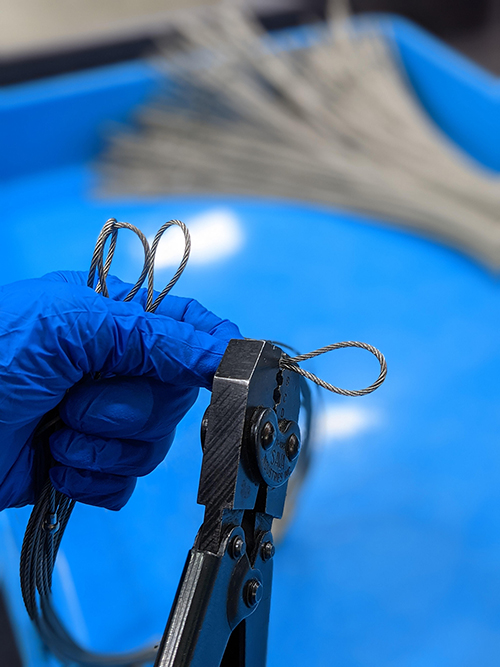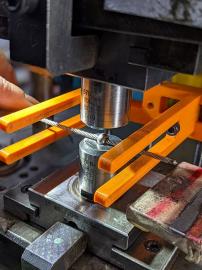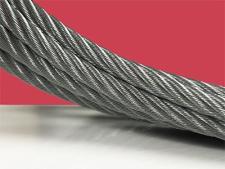Mechanical cable assemblies are commonly made to order. In other words, wire rope assemblies, also known as mechanical cable assemblies, are custom-made a good portion of the time. So, even if the customer is asking Carl Stahl Sava Industries to produce a quantity of a fixed length of tungsten cable, for instance, simply the way with which the cable is cut makes it a cable assembly. Often however, Sava is doing more than simply cutting the customer’s cable to length. In most cases a cable assembly actually comprises the wire rope itself, along with fittings - or cable components - attached to the cable. A ball might be added to each end, or perhaps a more specialized fitting is placed and pressed or swaged in the center of the cable. In short, adding a sleeve, ball and shank, threaded plug or other fitting makes the cable go from being a length of cable to a sophisticated cable assembly.
But how one goes about applying fittings to a cable is part of the exercise of producing custom mechanical cable assemblies.
Ways to Create Cable Prototypes
There are two fundamental ways to attach cable fittings to the cable strand itself. One involves using a hand tool known as a compound crimping tool or wire rope crimping tool and the other, an industrial press.
Wire Rope Crimping Tool
 Hand-held tools press the fitting to the cable using the forces applied by the tool user’s own strength. The hand tool possesses a cavity where the loose, uncrimped fitting nests. The fitting is fed into the cable according to the assembly’s requirements and crimping is achieved when the user squeezes the tool firmly. Often, crimping tools possess more than one cavity, allowing the tool to serve numerous custom cable assembly configurations, sizes and demands.
Hand-held tools press the fitting to the cable using the forces applied by the tool user’s own strength. The hand tool possesses a cavity where the loose, uncrimped fitting nests. The fitting is fed into the cable according to the assembly’s requirements and crimping is achieved when the user squeezes the tool firmly. Often, crimping tools possess more than one cavity, allowing the tool to serve numerous custom cable assembly configurations, sizes and demands.
Although a hand tool is preferable in situations where engineers are testing the efficacy of their mechanical cable assembly concepts, these hand-strength solutions are just that: dependent upon one’s hands. Thus, the consistency with which strength is applied to the crimp, as well as the nesting of the components in the tool cavity itself, yields a finished product only as strong and precise as the quality of the crimping operation. Add to that the potential for mating components to be inconsistently joined, one assembly to the next, and it’s easy to see that hand tools are fast and efficient for prototyping operations, but not production-worthy use.
Complicating matters further for the hand tool operator is the potential for the forces being applied by the hands to be insufficient with some materials and overly sufficient for others.
Brass is a malleable material, compared with, say, stainless steel. Using a hand tool to crimp a brass fitting to a length of mechanical cable will simply require less force than would be so were the fittings made of steel. Hand tools introduce the chance of a false failure in assembly concept purely due to the hand’s inability to sufficiently crimp steel to the cable. Said plainly, not attaching the steel fitting to the cable purely because the requisite strength was not present in the operator’s hand could yield false data. Conversely, the hand used to press a brass fitting to the cable can likely achieve the required force to complete the crimping operation successfully.
Industrial Press
The second common approach to applying cable fittings to cable is using an industrial press, which for all intents and purposes, mimics the behavior of hand crimping tool alternatives. But while similar in what each device achieves, the benefits of machine press far outweigh those of the hand tool, where prototypes must be as perfect as production parts.
First off, an industrial press is a factory machine that uses hydraulic force calibrated to the identical tonnage required by the engineering drawings. This scientifically-determined amount of force allows finished mechanical cable assemblies to be reliably produced one to the next. So, with a machine press joining mating parts together, the end result is that the first cable assembly coming off the press is identical to the one-millionth coming off the same press.
The added benefits to a press however, stretch far beyond their ability to reliably manufacturer custom mechanical cable assemblies. What makes the press even more impressive is that the machine ensures critical scientific priorities are achieved too. Application characteristics, such as the holding and breaking strength of the cable assembly, as well as the dimensional requirements, and even the shape of the crimped components, are assured using an industrial press.
Lastly, among the most common mistakes hand tool operators make is using too large a fitting in too small a cavity, or the reverse. Unlike in the hand tool solution, using an industrial press means an engineer and skilled press operator are assembling your prototypes. This ensures the added oversight to protect against using the wrong-sized cable fitting with the wrong tooling, or in the case of a hand tool, the wrong cavity.
The Precision of Custom-made Tools
Although hand tools allow the engineer the freedom to create prototypes at his/her will, and explore different permutations of the R&D process, the cavities that hand tools possess limit the designer’s ability to verify position of fittings, along with holding and overall strength. Failures to achieve the required dimensional and strength demands of the mechanical cable assembly can mean failure in the field -- not just in a lab. This is why Sava recommends producing prototypes on an industrial press.
When a press is used to attach fittings to cable, the cavity used to nest the fitting into position with the cable is a precise operation that can only be scientifically achieved with an industrial machine. First of all, the cavity is what is known as a “tool,” and this tool is custom-built by machining experts that go through a series of painstakingly complex engineering operations just to produce the cavity itself. What’s more, iterations to the tooling are made to ensure that a “Goldilocks” fit of mating components is achieved.
Even beyond the press allowing for custom-made tooling, the use of an industrial press also ensures dimensional precision through a sophisticated calibration exercise known as “the setup.”
Setup involves installing a series of custom-made guides, rails and backstops directly to the press itself and allows the operator to place the cable and fittings into a precise position every time. Properly setting up the press also honors regulatory standards permitting the manufacturer to possess strict credentials on scientific quality. In total, a soundly setup industrial press eliminates the variability present with a hand crimping tool and prevents the press operator from orientating the cable and/or the fittings themselves outside the engineering specification.
ISO Certification
When attaching cable fittings to cable using a hand tool, the variability inherent in a manual process doesn’t allow for the assembly maker to honor strict quality regulatory guidelines. Therefore, another advantage of using an industrial press is that the equipment, the operator and companion components are all subject to quality auditing. Sava is ISO 9001 certified, which assures you that our processes are accredited by a global governing body that certifies the quality with which our cable assemblies are made.
The choice between using a hand tool or industrial press to conduct your prototyping testing is determined by the application's needs. If you’re merely testing concepts, and can afford some variation in your data and outcomes, a hand crimping tool should suffice nicely. However, if precision parts are required and data verifiable, an industrial press and skilled press operator are both critical.
Key Takeaways
- Prototyping can be achieved with either a hand crimping tool or industrial press. The former affords the engineer the freedom to create and test at his/her will, whereas the latter ensures precision and scientific accountability.
- Even with small quantity prototyping production runs, using hand crimping tools introduces potential points of variability that lead to inconsistencies, inefficiencies and false data.
- An industrial press promises even a single prototyping sample, or perhaps millions of production-ready parts, are built with scientific precision, engineering oversight and achieve rigid ISO 9001 certification standards.
At Carl Stahl Sava Industries, we use leading-edge technology and equipment to produce high-quality prototype cable assemblies that improve the experience of engineers. Contact us today!






